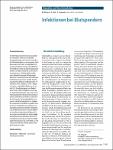Infektionen bei Blutspendern
Offergeld, Ruth
Stark, Klaus
Hamouda, Osamah
Die Verhinderung von transfusionsassoziierten Infektionen stellt eine der größten Herausforderungen der Transfusionsmedizin dar. Die Kombination von konsequenter Spenderauswahl und strikter Testung jeder Blutspende auf Infektionserreger mit validierten Testverfahren konnte das Übertragungsrisiko deutlich verringern. Durch die systematische Auswertung von infektionsepidemiologischen Daten können neue Risikogruppen identifiziert, neue Infektionen und unbekannte Infektionswege erkannt werden. Die engmaschige Surveillance von Blutspendern im Hinblick auf HIV-, Hepatitis-C-Virus-, Hepatitis- B-Virus- und Syphilisinfektionen, die gemäß § 22 Transfusionsgesetz vom Robert Koch-Institut (RKI) durchgeführt wird, trägt zur Aufrechterhaltung des sehr hohen Sicherheitsstandards bei Transfusionen in Deutschland bei. Die hierbei gewonnenen Daten helfen, Kriterien für die Spenderselektion anzupassen und die Notwendigkeit von etablierten und neuen Testverfahren zu prüfen. Darüber hinaus ermöglicht die Surveillance eine Abschätzung des verbleibenden Infektionsrisikos bei Bluttransfusionen. Über die bekannten transfusionsrelevanten Infektionen hinaus müssen zunehmend auch andere Infektionskrankheiten, beispielsweise West-Nil-Virusinfektionen oder die variante Creutzfeldt- Jakob-Erkrankung (vCJK), im Hinblick auf ihre Transfusionsrelevanz infektionsepidemiologisch bewertet werden. Avoiding transfusion-associated infections is one of the greatest challenges for transfusion medicine. The combination of consequent donor selection and state of the art testing of every donation has substantially reduced the risk of transfusion-associated infections. Infectious disease surveillance provides information on new and emerging infections and can identify new sources of infection. Close surveillance of the blood donor population with regard to HIV, hepatitis C, hepatitis B and syphilis infections, as warranted by § 22 of the Transfusion Act by the Robert Koch-Institute, helps to maintain the high degree of transfusion safety in Germany. Criteria for donor selection and testing can subsequently be modified. Infectious disease surveillance in the blood donor population is also necessary in order to calculate the current residual risk of transfusion-transmitted infections. Apart from the known transfusion-relevant infections,emerging infections such as West Nile virus and variant Creutzfeldt-Jakob disease have to be epidemiologically evaluated with regard to transfusion medicine.
Files in this item
No license information

